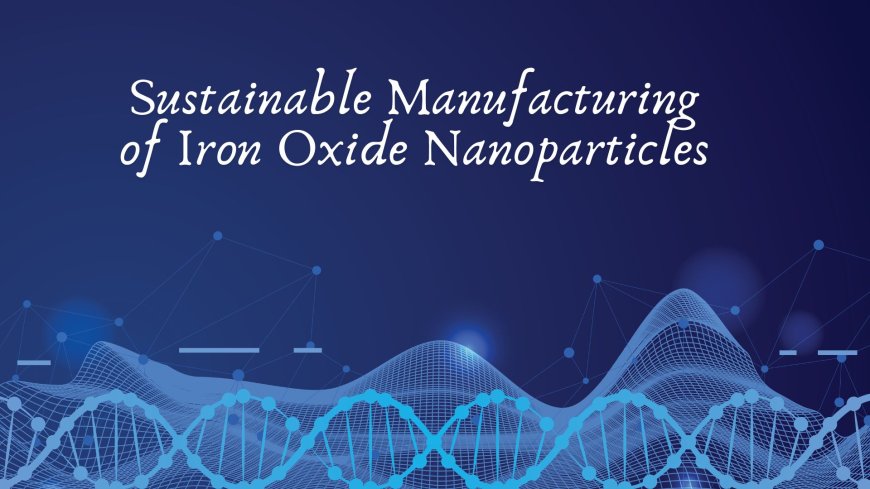Sustainable Manufacturing of Iron Oxide Nanoparticles
The shift toward sustainable manufacturing of iron oxide nanoparticles marks a crucial step in aligning nanotechnology with global sustainability goals

Introduction
Iron oxide nanoparticles (IONPs) are among the most widely used nanomaterials due to their unique magnetic, catalytic, and biocompatible properties. They have found applications across diverse industries, including biomedicine, environmental remediation, energy storage, and electronics. However, the conventional methods of synthesizing IONPs often involve toxic chemicals, high energy inputs, and non-renewable resources, leading to environmental and health concerns. In response, researchers and industries alike are increasingly focusing on sustainable manufacturing approaches that prioritize environmental responsibility, resource efficiency, and economic viability.
Understanding Iron Oxide Nanoparticles
Iron oxide nanoparticles typically include magnetite (Fe?O?) and maghemite (?-Fe?O?), known for their superparamagnetic properties and high surface area-to-volume ratio. These features make them suitable for use in:
-
Targeted drug delivery
-
Magnetic resonance imaging (MRI)
-
Wastewater treatment
-
Catalysis
-
Sensors and batteries
Despite these advantages, the need for eco-friendly production methods is more urgent than ever, as unsustainable manufacturing can offset the potential environmental benefits of IONP applications.
The Environmental Challenges of Conventional Synthesis
Traditional chemical and physical methods for synthesizing iron oxide nanoparticles include co-precipitation, hydrothermal synthesis, sol-gel processes, and thermal decomposition. While effective in controlling particle size and morphology, these methods often:
-
Use toxic solvents and surfactants
-
Require high energy inputs and harsh conditions
-
Generate significant waste streams
-
Rely on non-renewable raw materials
Such drawbacks compromise the sustainability of the production process and pose risks to ecosystems and human health.
Principles of Sustainable Manufacturing
Sustainable manufacturing of IONPs aligns with the principles of green chemistry and green engineering, which emphasize:
-
Minimization of hazardous substances
-
Energy efficiency
-
Use of renewable feedstocks
-
Waste prevention
-
Life cycle thinking
By incorporating these principles, manufacturers can reduce the ecological footprint of IONP production while maintaining or enhancing performance and quality.
Green Synthesis Methods for Iron Oxide Nanoparticles
Biological Synthesis (Green Biosynthesis)
One of the most promising approaches is biosynthesis using natural biological entities like:
-
Plants (leaf, bark, root extracts)
-
Bacteria and fungi
-
Algae
These organisms contain biomolecules (e.g., polyphenols, proteins, enzymes) that act as reducing and capping agents. Key benefits include:
-
Non-toxic by-products
-
Ambient temperature and pressure reactions
-
Renewable and biodegradable resources
For example, plant-mediated synthesis using Camellia sinensis (green tea) or Azadirachta indica (neem) has yielded stable IONPs with antimicrobial and catalytic properties.
Microwave-Assisted Synthesis
Microwave irradiation offers a fast, uniform, and energy-efficient way to synthesize IONPs. Unlike conventional heating, microwave synthesis:
-
Reduces reaction time drastically
-
Enhances yield and crystallinity
-
Minimizes solvent use
When coupled with green precursors, it becomes a powerful tool for sustainable manufacturing.
Mechanochemical Methods
Mechanochemical synthesis involves high-energy ball milling, eliminating the need for solvents altogether. This solvent-free approach is:
-
Scalable
-
Cost-effective
-
Environmentally benign
Additionally, it can be integrated with recyclable iron precursors from industrial waste streams.
Supercritical Fluid Techniques
Using supercritical CO? as a reaction medium provides a clean, tunable environment for nanoparticle synthesis. Advantages include:
-
Low toxicity
-
Easy separation of nanoparticles
-
Reduced solvent waste
Although still under research, this method shows significant promise for industrial-scale sustainable production.
Industrial Integration and Circular Economy Approaches
Industries are exploring ways to integrate sustainable IONP production into circular economy models, including:
-
Waste valorization: Using iron-rich waste from metallurgy, electronics, or mining as raw material.
-
Closed-loop systems: Recycling solvents and reagents to minimize waste.
-
Green supply chains: Sourcing renewable biological inputs and minimizing carbon footprints.
Additionally, life cycle assessment (LCA) tools are being employed to evaluate and optimize the environmental performance of IONP manufacturing systems.
Challenges and Future Directions
Despite advancements, sustainable IONP manufacturing faces several challenges:
-
Standardization: Variability in green sources can affect reproducibility and quality.
-
Scalability: Some green methods are not yet viable for large-scale production.
-
Cost competitiveness: Initial costs may be higher compared to conventional methods.
Future research is focusing on:
-
Enhancing yield and control over nanoparticle morphology in green methods
-
Developing hybrid synthesis techniques combining biological and physical methods
-
Automating and scaling low-impact manufacturing systems
-
Improving regulatory frameworks and certification systems for sustainable nanomaterials
Conclusion
The shift toward sustainable manufacturing of iron oxide nanoparticles marks a crucial step in aligning nanotechnology with global sustainability goals. By adopting green chemistry principles and innovative synthesis techniques, researchers and industries can reduce environmental harm while unlocking new functional potentials of IONPs. As these eco-friendly methods continue to evolve, they promise not only safer production processes but also a more resilient and responsible nanomaterials industry.




































